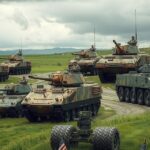Politics
ASIA, BEIJING, CHINA, CHINA ’ S COAST GUARD, COAST GUARD, DEFENSE, EASTERN THEATER COMMAND, KOO, LAI, LAI CHING - TE, MEXICO, MILITARY, NORTH AMERICA, PEOPLE ’ S LIBERATION ARMY, SHANDONG, SHI YI, SOUTH CHINA SEA DISPUTE, TAIWAN, TAIWAN AFFAIRS OFFICE, TERRITORIAL DISPUTES, WELLINGTON KOO, ZHU ANQIN
Dante Raeburn
Chinese Military Conducts Extensive Drills Around Taiwan Amid Rising Tensions
The Chinese military has initiated extensive drills surrounding Taiwan to deter independence aspirations. The exercises encompass naval and aerial operations, viewed as a serious threat by Taiwan, which monitors the situation closely. President Lai Ching-te’s pro-independence stance provokes China’s response as Taiwan enhances its military capabilities amid ongoing tensions.
The Chinese military has commenced large-scale military drills around Taiwan, aimed at warning the island against pursuing independence. These joint exercises involve navy, air, ground, and rocket forces and serve as a severe threat of containment against Taiwan’s sovereignty, according to Shi Yi, spokesperson for the People’s Liberation Army’s Eastern Theater Command.
China considers Taiwan a part of its territory, insisting on reunification, potentially through force if necessary. In contrast, a significant portion of Taiwanese citizens advocate for their independence and democratic governance. Taiwan’s Ministry of National Defence reported monitoring 19 Chinese naval vessels near the island over 24 hours and tracking the movements of the Shandong aircraft carrier within its self-defined identification zone.
Taiwan’s Defense Minister Wellington Koo commented, saying, “These actions amply reflect its destruction of regional peace and stability.” In response, Taiwan has established a central response group to oversee the drills. Additionally, China’s Coast Guard announced that it would conduct law enforcement patrols around Taiwan, intensifying the military presence in the area.
These exercises follow a similar large-scale drill executed two weeks earlier, characterized by extensive deployments of drones and ships toward Taiwan. The Chinese Taiwan Affairs Office targeted Taiwan’s president, Lai Ching-te, stating that his unwavering commitment to a pro-independence agenda stirs anti-China sentiments and provokes unrest.
In mid-March, President Lai proposed a 17-point strategy to enhance Taiwan’s national security, including allowing military courts to handle espionage cases and stricter immigration laws for Chinese citizens. Beijing routinely sends aircraft and naval vessels toward Taiwan to undermine its defenses, despite the majority of Taiwanese rejecting China’s sovereignty claims.
Zhang Chi, a professor at China’s National Defense University, noted that the PLA’s drills included practicing precision strikes on key Taiwanese targets from various angles. In light of increasing threats from China, Taiwan is enhancing its military capabilities by procuring new weapons and improving its defense industry, drawing assistance from the U.S.
The historical backdrop of tensions is rooted in the civil war that led to the split between Taiwan and China 76 years ago, with communication efforts between the two regions diminishing in recent years.
In summary, the Chinese military’s recent initiation of large-scale drills around Taiwan signifies heightened tensions, showcasing China’s attempts to assert control while Taiwan responds by strengthening its defenses. The political dynamics reveal deep-seated issues regarding Taiwan’s sovereignty and independence, underscored by China’s strict stance against any pro-independence movements. The situation remains critical as both sides prepare for potential escalations in military confrontations amidst a backdrop of deteriorating communications.
Original Source: apnews.com








Post Comment